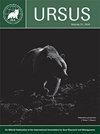Effects of roads and motorized human access on grizzly bear populations in British Columbia and Alberta, Canada
IF 0.6
4区 生物学
Q4 ZOOLOGY
引用次数: 56
Abstract
Abstract: The growing human footprint has placed unprecedented stressors on ecosystems in recent decades resulting in losses of biodiversity and ecosystem function around the world. Roads are influential through their direct footprint and facilitating human access; however, their influence can be mitigated. Here, we review the scientific literature on the relationship between grizzly bears (Ursus arctos), human motorized access, and the efficacy of motorized access control as a tool to benefit grizzly bear conservation in western Canada. We found that motorized access affected grizzly bears at the individual and population levels through effects on bears' habitat use, home range selection, movements, population fragmentation, survival, and reproductive rates that ultimately were reflected in population density, trend, and conservation status. Motorized access management was effective in mitigating these effects. Our review of the scientific literature suggests that industrial road management would be a useful tool if (a) roads exist in high-quality grizzly bear habitats with population-energy-rich food resources; (b) open road densities exceed 0.6 km/km2; (c) less than at least 60% of the unit's area is >500 m from an open road in patch sizes of ≥10 km2. Motorized access management would be most beneficial in threatened populations, in areas where roads occur in the highest quality habitats, within and adjacent to identified linkage areas between population units, and in areas that are expected to exceed motorized route thresholds as a result of resource extraction activities. Evidence suggests benefits of motorized access management are more likely to be realized if habitat quality is integrated and is best if managed at scales that optimize the benefit of distribution, survival, reproduction, and density of female grizzly bears. We encourage land use managers developing access rules to consider a wider spectrum of biodiversity and overall habitat conservation, and suggest landscape road targets that will benefit bear conservation.加拿大不列颠哥伦比亚省和阿尔伯塔省道路和机动人类通道对灰熊种群的影响
摘要近几十年来,人类足迹的增加给生态系统带来了前所未有的压力,导致全球生物多样性和生态系统功能的丧失。道路通过其直接足迹和便利人类通行而具有影响力;然而,它们的影响是可以减轻的。在此,我们回顾了加拿大西部灰熊(Ursus arctos)与人类机动通道之间的关系,以及机动通道控制作为一种有利于灰熊保护的工具的有效性。研究发现,机动通道在个体和种群层面上对灰熊的栖息地利用、栖息地选择、迁徙、种群碎片化、生存和繁殖率产生影响,最终反映在种群密度、趋势和保护状况上。机动访问管理在缓解这些影响方面是有效的。我们对科学文献的回顾表明,工业道路管理将是一个有用的工具,如果:(a)道路存在于高质量的灰熊栖息地,具有人口能量丰富的食物资源;(b)开放道路密度超过0.6公里/平方公里;(c)至少60%的单位面积距离开放道路>500米,斑块大小≥10 km2。机动通道管理对下列地区最为有利:受威胁的人口、在质量最高的生境中有道路的地区、在人口单位之间确定的联系地区内和邻近地区,以及由于资源开采活动预计将超过机动通道阈值的地区。有证据表明,如果栖息地质量得到整合,机动通道管理的效益就更有可能实现,如果在优化雌性灰熊分布、生存、繁殖和密度的规模上进行管理,则效果最好。我们鼓励土地利用管理者在制定准入规则时考虑更广泛的生物多样性和整体栖息地保护,并提出有利于熊类保护的景观道路目标。
本文章由计算机程序翻译,如有差异,请以英文原文为准。
求助全文
约1分钟内获得全文
求助全文
来源期刊

Ursus
生物-动物学
CiteScore
2.00
自引率
15.40%
发文量
12
审稿时长
>12 weeks
期刊介绍:
Ursus includes a variety of articles on all aspects of bear management and research worldwide. Original manuscripts are welcome. In addition to manuscripts reporting original research, submissions may be based on thoughtful review and synthesis of previously-reported information, innovative philosophies and opinions, and public policy or legal aspects of wildlife conservation. Notes of general interest are also welcome. Invited manuscripts will be clearly identified, but will still be subject to peer review. All manuscripts must be in English. All manuscripts are peer-reviewed, and subject to rigorous editorial standards.
 求助内容:
求助内容: 应助结果提醒方式:
应助结果提醒方式:


